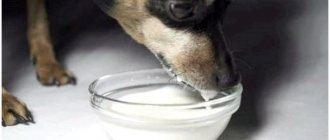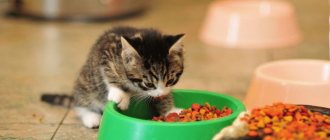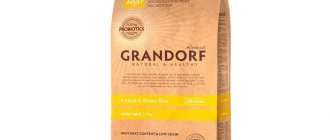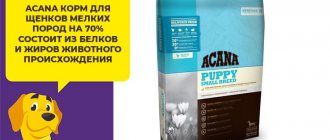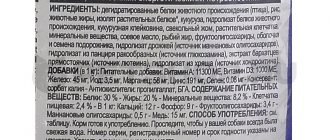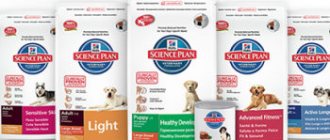Many pet owners decide to switch their dogs to ready-made food in order to save time. To ensure a complete, balanced diet, you need to spend a lot of effort preparing meals that will contain the correct ratio of vegetables, meat, and grains. In the finished product, all this is already calculated. But in this process it is important to follow the rules and know exactly how to switch your dog to dry food.
Ready-made granules contain all the necessary vitamins
Why do you need to switch your dog from natural food to ready-made food?
The need to change your diet may be due to medical reasons. These include:
- disruption of the functioning of the pet’s gastrointestinal tract, frequent diarrhea and vomiting;
- development of an allergic reaction;
- excess weight or, conversely, underweight;
- lack of vitamins.
Important !
If the animal is lethargic, its hair begins to fall out, its nails and teeth are in poor condition, this may indicate a lack of vitamins and microelements.
Feeding rules when using industrial feed
Dry food consumption rates are usually highlighted in a separate block on the packaging. However, these figures are very approximate. The amount of feed required by each animal depends on many parameters. The main factors are the weight of the dog, its activity during the day and the energy value of drying.
Manufacturers offer a wide range of dry food
Economy class dry food usually has a poor composition. Accordingly, the dog requires a large portion to satisfy its hunger. In addition, such a diet implies the introduction of complementary foods containing substances necessary for the dog, which are not included in this drying.
Premium dry food is more balanced. They consist of protein components and include all the vitamins and microelements a dog needs.
To calculate the optimal amount of food for a dog, it is necessary to take into account that working animals, as well as lactating bitches, need an increased portion. For active dogs, the norm indicated on the package is increased by a third; for pregnant and lactating bitches, a quarter of the total recommended portion is added.
Proper feeding of a pregnant bitch is the key not only to her health, but also to the well-being of the entire litter after birth. You can read more about how to understand that a dog is pregnant in our separate article.
A pregnant dog needs more food
For older animals and those animals that lead a sedentary lifestyle, lying on the couch most of the day, it is advisable to reduce the portion by ¼. This will avoid overeating and, as a result, obesity.
According to statistics, about 40% of dogs are obese. Obesity is a condition in which excess fat is deposited in the subcutaneous tissue and other tissues. Dogs, like people, are also affected by this problem. You can read more about obesity in dogs in our special article.
Table 1. Recommended doses of premium food for different dogs.
| Dog weight | Amount of food per day for active dogs | Daily Value for Dogs with Low Activity Levels |
| 2 kg | 60 g | 30 g |
| 5 kg | 90 g | 60 g |
| 10 kg | 160 g | 120 g |
| 20 kg | 280 g | 180 g |
| 30 kg | 390 g | 240 g |
| 40 kg | 480 g | 320 g |
| 50 kg | 560 g | 360 g |
| 60 kg | 640 g | 420 g |
We should not forget about the feeding regime. The dog must eat strictly at the allotted time. If possible, you should avoid feeding during the day. This is especially true for food from the table. Human food contains too many spices and is absolutely not suitable for a dog's diet. In addition, such complementary foods disrupt the feeding schedule. As a result, when feeding time approaches, the dog simply will not eat because he does not feel hungry.
Special feeders make feeding even more convenient
Video - how to choose dry dog food
Pros and cons of dry feeding
Ready-made dry mixtures are very popular among breeders. But, giving preference to this type, you need to follow certain rules:
- It is necessary to choose a diet in accordance with the age of the dog.
- It is important to observe the daily intake and number of feedings.
- Ensure constant access to drinking water.
Dry feeding has a number of advantages and disadvantages. The advantages of this type include:
- simplicity;
- the ability to go on the road with your pet without disturbing its diet;
- balanced composition, which contains all the vitamin and mineral supplements necessary for health;
- wide selection of flavors.
The disadvantages include:
- possible occurrence of allergic reactions;
- soy content in economy class products;
- the food is produced under the influence of high temperatures, this leads to the destruction of vitamins;
- presence of preservatives.
Important ! Veterinarians warn that the use of economy-class food can lead to the development of allergic reactions and chronic diseases.
Ready-made granules significantly reduce the time required to care for your pet
Typical translation cases
Most often, dog owners decide to switch their pets to dry kibble due to lack of time. Not everyone has the opportunity to prepare a variety of dishes every day that will contain a full range of vitamins and minerals.
The best way to feed your pet: recommendations from a nutritionist
Small puppies have not yet developed taste preferences, so they are not picky about their diet.
You can feed your pet the same foods every day. However, some dog owners want to pamper their pets with various delicacies, as a result of which the animal begins to pick at food. At the same time, we should not forget that the dog belongs to the group of predatory animals that prefer to eat meat. But for normal development they need not only fats, but also carbohydrates, as well as other groups of nutrients. Simply put, your pet's diet should be balanced.
Bones are an essential part of a dog's proper diet. They are rich in protein, collagen and other substances vital for a pet. But there are a number of products, such as treats, corn, potatoes and others, which are strictly prohibited from being given to an animal. All this turns diet planning into a real problem. Dry food comes to the aid of dog owners, which contains all the nutrients necessary for the animal. Therefore, it is very important to know how to properly transfer a puppy to dry food.
Features of dry food
When choosing a finished product, you need to focus on the pet’s age, state of health, and dimensions. Products are divided into several categories.
Holistics
These are granules of the highest quality, they consist entirely of natural ingredients. The disadvantage of this type is its price. It will cost a lot more compared to lower-end options.
Super premium
This product contains 50% natural meat. The food does not contain low-quality by-products, flavor enhancers, or flavorings. It is well suited for both adult dogs and small puppies when transitioning from milk feeding.
Premium class
Feeds of this type may contain dyes, flavors, and preservatives. There is no meat in the composition, it is replaced by offal.
Economy class
This is the cheapest product, extremely questionable in quality. It is absolutely not suitable for purebred pets: Spitz, Chihuahua, German Shepherd and other breeds. Since it contains few vitamins and minerals and low calorie content, the animal requires a larger portion compared to natural food.
For purebred dogs, it is recommended to purchase only high quality products
Procedure for switching to dry food
Changing diet is stressful for a dog. Therefore, you must follow all recommendations.
Peculiarities
You need to gradually accustom your pet to unusual food. Veterinarians have developed a universal scheme:
- It is not recommended to give your pet dry kibble right away. They need to be soaked in water.
- At the first feeding, dry food is mixed with the usual food in a 1:2 ratio.
- Every week the volume of granules increases.
Important ! During the transition process, you need to monitor the change in your pet's condition.
Feeding standards when switching to dry food
The final transition is possible only after a few months. In the first 30 days, the granules need to be constantly soaked. Portions should be divided to feed the dog several times a day.
The calculation is 100 g per 10 kg of animal weight. Gradually the daily norm is increased to 50 g per day. The share of natural food should not be more than 10% of the total volume.
What to do if your dog doesn't want to eat dry food
Not all dogs tolerate the transition to dry food well. Some owners in such a situation stop giving other food altogether, offering the pet only food. In this case, water should be in unlimited quantities.
But there are special breeds with which even this method does not produce results. For example, due to its independent nature, it is very difficult to retrain a Yorkie. In especially severe cases, it is better to abandon the idea of transfer and continue to feed the pet with its usual food.
In the first days, granules can be added to regular food.
Menu for the first week
It is necessary to determine exactly how much food your pet eats per day. This volume is divided into seven techniques. In the first two days, one part of the natural food is replaced with dry food. Two days later, two parts are replaced.
If the dog immediately refuses new food, it can be mixed with the usual dog porridge.
Tips for transitioning from a natural diet
The transition should be carried out no earlier than within two weeks.
Important !
You cannot switch your pet to dry food on the same day. This will lead to stomach upset.
Gradualism is the key to victory
Separation from the mother and moving are already a serious test for a puppy, so try to make the change in feeding as smooth as possible. Find out what the baby was fed at the breeder's house, and for the first days stick to a similar menu, even if you understand that it is incorrect. During this period, you will already have a difficult time: most likely, the baby will be sad, worried and looking for his mother.
As soon as the puppy adapts at home, start introducing him to the new food. Try offering pellets by hand as a reward first. For example, when you teach a new family member the simplest commands: “Place”, “Come” and others. Dogs have an excellent memory for smells. In the future, when the puppy smells the aroma of food, he will associate it exclusively with praise and pleasant emotions.
If your pet willingly eats from your hands, try going further and completely replacing one feeding with “drying”. In this case, the granules can be pre-soaked in warm water so that they more closely resemble the natural food familiar to the puppy in appearance and consistency. On the second day, replace another feeding with dry food, and so on, until you completely transfer the baby to the new diet.
Normally, such a transition should take 5–7 days. Do not try to speed it up, otherwise the animal may have problems with digestion. The same applies to cases when it is necessary to switch the dog to another brand of ready-made food.
Problems when switching a dog to dry food
Pet owners often make mistakes when switching from a natural diet to a dry diet.
Abrupt transition to natural food and its consequences
The most common mistake is a sudden change in nutrition. The body does not have time to adapt, which causes disturbances in the functioning of the gastrointestinal tract. A dog may categorically refuse new food if it is not prepared for this in advance.
If the transition plan is not followed, the animal may develop stomach problems.
If the food is not suitable
You shouldn't buy a lot of food at once. The pet may refuse it. Often owners have to try several types.
Age
If you don't know how to transition your puppy to dry food, the first thing you should consider is your pet's age. The number of feedings depends on it. The younger the dog, the more meals it needs because its developing body needs more nutrients.
Depending on age, the following number of feedings is necessary:
- from 1 to 2 months - 6-7;
- from 2 to 3 months - 4-5;
- from 4 to 6 months - 3-4;
- from 6 to 12 months - 3;
- after 12 months - 2, morning and evening.
In this case, you should take into account the fact that you need to feed strictly at the same time, since a violation of the diet can have a bad effect on the health of the animal.
